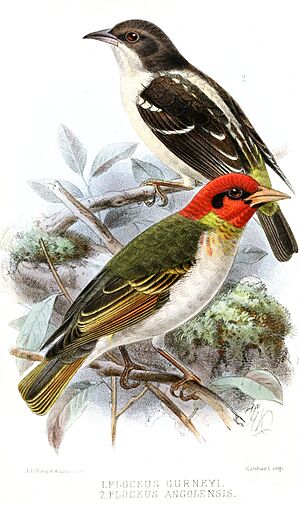Bar-winged weaver facts for kids
Quick facts for kids Bar-winged weaver |
|
|---|---|
 |
|
| An illustration of the bar-winged weaver (bird in the background) with a red-headed weaver (in the foreground). | |
| Conservation status | |
| Scientific classification | |
| Genus: |
Ploceus
|
| Species: |
angolensis
|
The bar-winged weaver (scientific name: Ploceus angolensis) is a small, colorful bird. It belongs to the Ploceidae family, which includes many types of weavers. You can find this bird in parts of Angola, the Democratic Republic of the Congo, and Zambia.
Contents
What Does the Bar-winged Weaver Look Like?
This weaver is about 13 centimeters (about 5 inches) long. It has dark feathers on its upper body and lighter ones underneath. The top of its head and its wings are covered in a dark, blackish-brown color.
Unique Wing Markings
A cool feature of the bar-winged weaver is the white tips on its wing feathers. Female weavers have even more white on their wings than males. There's also a yellow stripe that runs down the middle of their back. Their tail is the same blackish-brown color as their head and wings.
Body Colors and Features
The bird's chin and belly have a mix of white and yellow, with females often looking whiter. Its beak is black, its legs are brown, and its eyes have a bright red color.
What Do Bar-winged Weavers Eat?
Bar-winged weavers are mostly insectivores, which means they eat insects. They especially enjoy eating mantids, beetles, and fly larvae.
How They Find Food
These birds are clever hunters. They look for their food on trees that are covered with lichens and a plant called Usnea. They move around on the trees a lot, similar to how nuthatches climb, to find hidden insects.
Where Do Bar-winged Weavers Live?
Bar-winged weavers prefer to live in specific types of forests. They like mature evergreen forests, especially those with Cryptosepalum trees. They also live in Miombo woodlands.
Their Ideal Home
These woodlands need to be moist enough for Usnealichen to grow on the trees. This shows how important certain plants are for their habitat and food source.
What Sounds Do Bar-winged Weavers Make?
The bar-winged weaver isn't a very loud bird, but it has a unique song. Its song starts with several fast, musical notes that get louder, building up to a loud "swizzle" sound. Sometimes, it follows this with more musical notes that get quieter.
Other Calls
Occasionally, they make a series of high-pitched squeaks, buzzes, and churrs. You might also hear them call out sounds like "tyoo-vo-vo-vo" or a higher-pitched "tree-zi-zee-zi-zee-zi."
How Do Bar-winged Weavers Breed?
Unlike some birds that live in big groups, the bar-winged weaver is a solitary breeder. This means they usually breed alone, not in colonies. They are also monogamous, meaning a male and female pair stay together for breeding.
Building Their Nests
Their nest is shaped like a rough ball. It has an entrance tube that hangs down from one side, which can be anywhere from 30 to 210 millimeters long. One interesting nest even had a fake entrance leading to an empty chamber, perhaps to trick predators!
Their Eggs
A female weaver usually lays 2 to 3 eggs. These eggs are a beautiful turquoise-blue color. They have darker spots and cloudy markings, especially at the wider end of the egg.
Are Bar-winged Weavers in Danger?
The bar-winged weaver is a species that scientists don't know a lot about. It's quite uncommon in the places where it's found.
Conservation Efforts
Even though it's not very common, the bird is not considered to be globally threatened. This is good news! You can find these birds in protected areas in Zambia, which helps to keep them safe.


